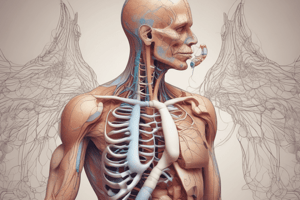Podcast
Questions and Answers
What is the primary function of the respiratory system?
What is the primary function of the respiratory system?
- To regulate body temperature
- To filter out dust and other particles from the air
- To bring oxygen into the body and remove carbon dioxide (correct)
- To produce sound through the voice box
What happens to the diaphragm during inspiration?
What happens to the diaphragm during inspiration?
- It remains unchanged
- It contracts and flattens (correct)
- It descends and expands
- It relaxes and rises
What is the site of gas exchange in the respiratory system?
What is the site of gas exchange in the respiratory system?
- Trachea
- Bronchi
- Alveoli (correct)
- Pharynx
What regulates breathing rates in the body?
What regulates breathing rates in the body?
What is the function of the upper respiratory tract?
What is the function of the upper respiratory tract?
What is removed from the body through the respiratory system?
What is removed from the body through the respiratory system?
Flashcards are hidden until you start studying
Study Notes
Overview of the Respiratory System
- The respiratory system is a biological system that brings oxygen into the body and removes carbon dioxide.
- It consists of the lungs, airways, breathing muscles, and blood vessels that allow for gas exchange.
Upper Respiratory Tract
- The upper respiratory tract includes the:
- Nose and mouth (entrance points for air)
- Pharynx (throat)
- Larynx (voice box)
- Trachea (windpipe)
Lower Respiratory Tract
- The lower respiratory tract includes the:
- Bronchi (airways that branch off from the trachea)
- Bronchioles (smaller airways that branch off from the bronchi)
- Alveoli (small air sacs where gas exchange occurs)
Mechanism of Breathing
- Inspiration (breathing in):
- Diaphragm contracts and flattens
- Rib cage expands
- Air enters the lungs through the mouth or nose
- Expiration (breathing out):
- Diaphragm relaxes and rises
- Rib cage descends
- Air leaves the lungs through the mouth or nose
Gas Exchange
- Oxygen from the air we breathe diffuses into the blood through the alveoli
- Carbon dioxide from the blood diffuses into the alveoli and is exhaled out of the body
Regulation of Breathing
- The brain's respiratory center regulates breathing rates
- Chemoreceptors in the body monitor oxygen and carbon dioxide levels and adjust breathing rates accordingly
Functions of the Respiratory System
- Brings oxygen into the body
- Removes carbon dioxide from the body
- Regulates pH levels by removing excess hydrogen ions
- Helps to filter out dust and other particles from the air we breathe
Studying That Suits You
Use AI to generate personalized quizzes and flashcards to suit your learning preferences.




